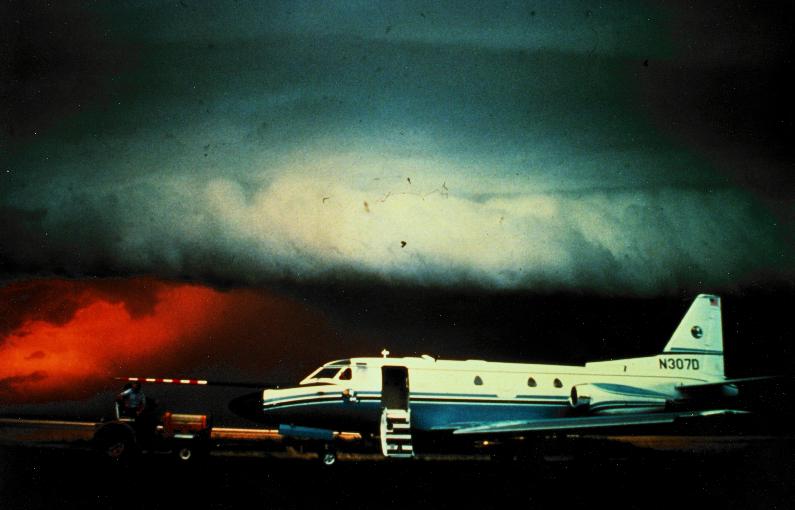Research on Thunderstorms and Air Chemistry

The NCAR Sabreliner, used extensively in thunderstorm studies.
Click here for a nice photo of
thunderheads by Ansel Adams.
Meteorological processes such as thunderstorms can profoundly alter the chemistry
of the atmosphere. For example, nitrogenous pollutants (NOx) emitted near the
Earth's surface tend to remain near the surface where they have a lifetime on the
order of a day. If however, a thunderstorm rolls over the area of emissions the
pollutants are transported to high altitude where their sphere of influence is
greatly expanded. Local air pollution problems are thus transformed into
regional or even global air chemistry problems. As a first step in quantifying
the effect on regional air chemistry, we prepared a climatology of convection to
show how often such transport occurs and then presented a detailed analysis of
results from extensive aircraft flights. With ESSIC and NASA Goddard colleagues,
we simulated several case studies with a combination of a mesoscale cloud model
and a photochemical model to show the effect of clouds on the rate of ozone
production. The effects vary greatly, ranging from a slightly enhanced
destruction of ozone over the tropical Pacific to a factor of 60 times faster
ozone production over heavily polluted areas.
Thunderstorms: An Important Mechanism in the Transport of Air
Pollutants, R. R. Dickerson, G. J. Huffman, W. T. Luke, L. J. Nunnermacker,
K. E. Pickering, A. C. D. Leslie, C. G. Lindsey, W. G. N. Slinn, T. J. Kelly,
A. C. Delany, J. P. Greenberg, P. R. Zimmerman, J. F. Boatman, J. D. Ray and
D. H. Stedman, Science, 235, 460-465, 1987.
Pickering, K. E.,et al., Convective transport of biomass burning
emissions over Brazil during TRACE-A, J. Geophys. Res.,
101, 23,993-24,012, 1996.
Allen DJ, Pickering KE
Evaluation of lightning flash rate parameterizations for use in a global chemical transport model,
J. Geophys. Res., 107 (D23): Art. No. 4711 DEC 11 2002.
DeCaria AJ, Pickering KE, Stenchikov GL, et al., Lightning-generated NOX and its impact on tropospheric
ozone production: A three-dimensional modeling study of a Stratosphere-Troposphere Experiment: Radiation,
Aerosols and Ozone (STERAO-A) thunderstorm, J. Geophys. Res., 110 (D14): Art. No. D14303 JUL 22 2005.
Hyer EJ, Allen DJ, Kasischke ES,
Examining injection properties of boreal forest fires using surface and satellite measurements of CO transport
JOURNAL OF GEOPHYSICAL RESEARCH-ATMOSPHERES, 112 (D18): Art. No. D18307 SEP 25 2007.
|

